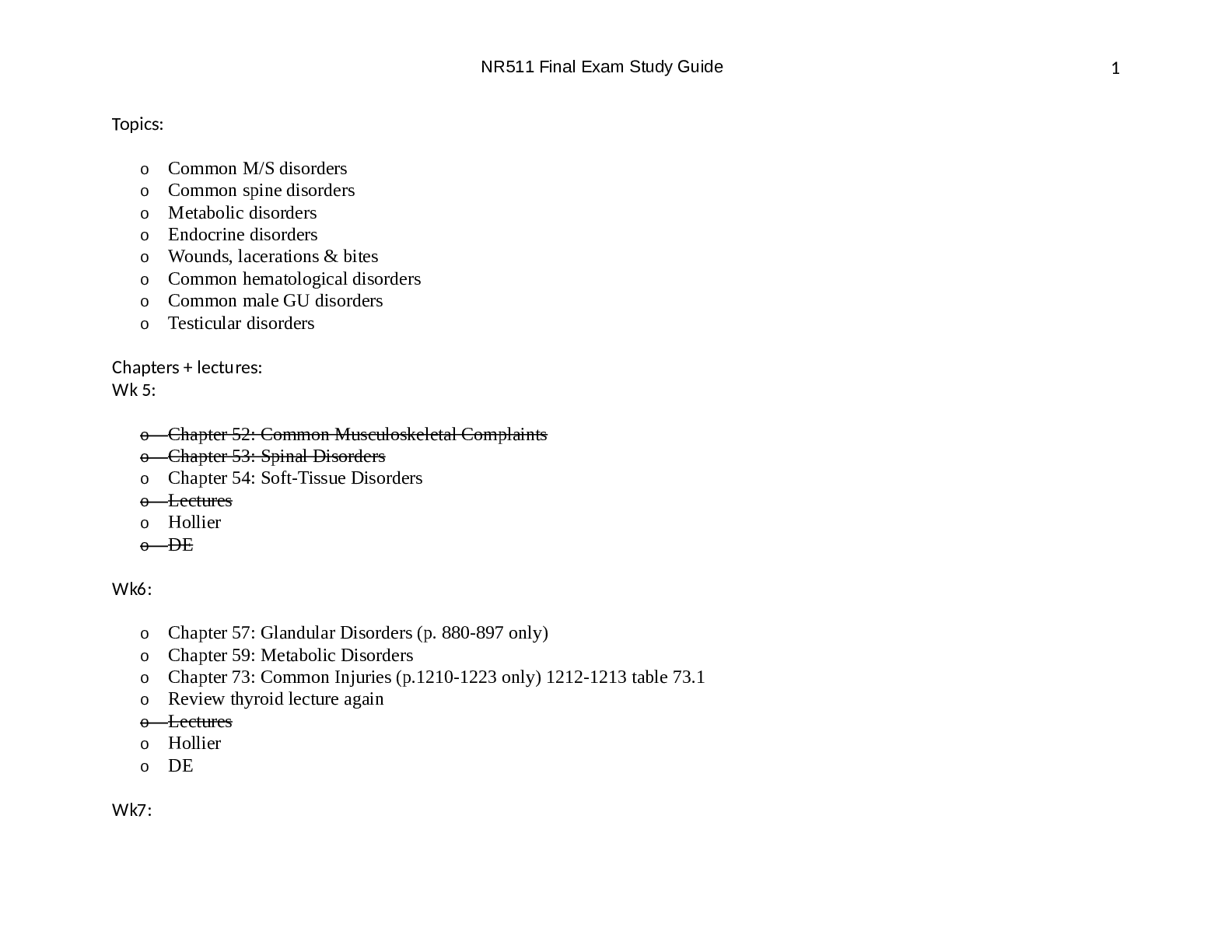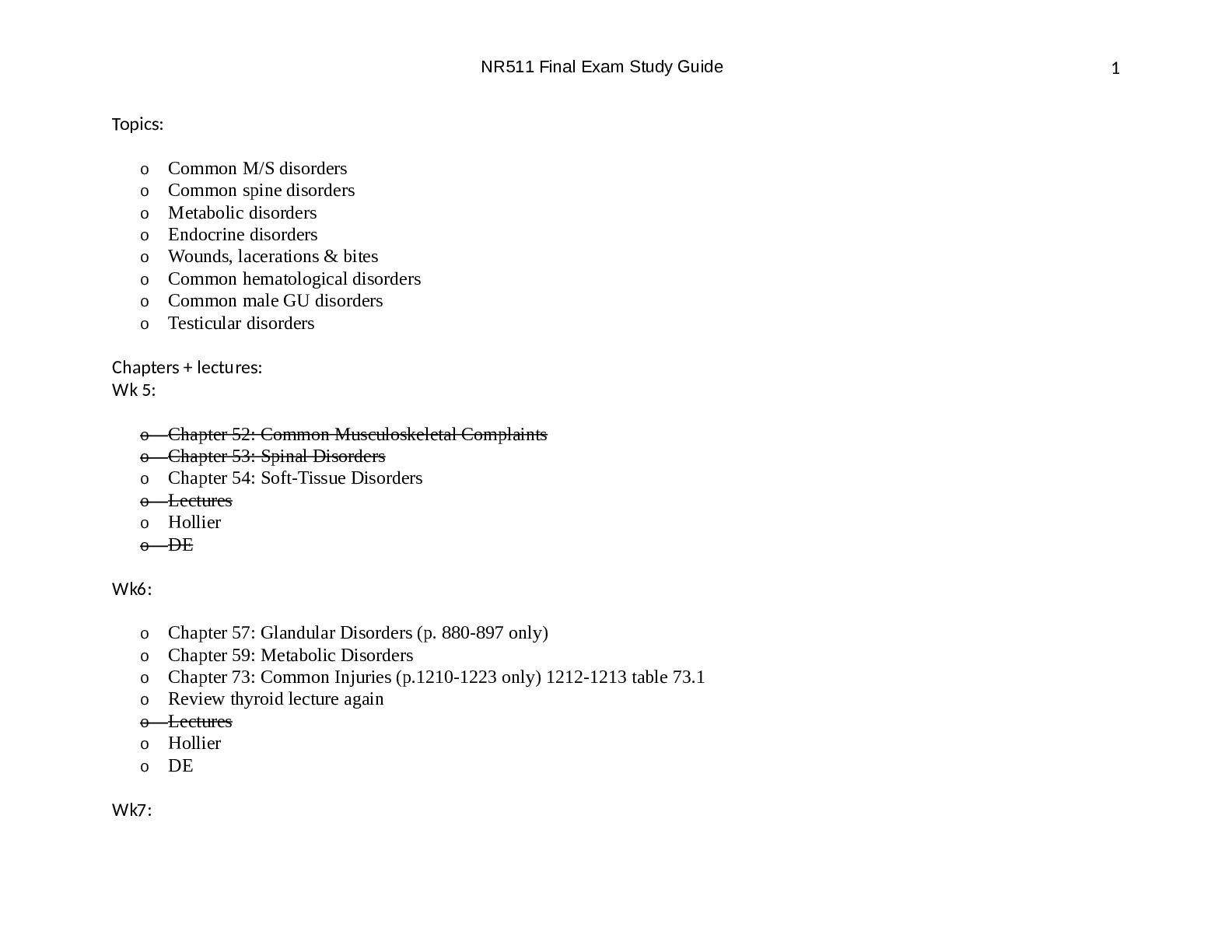Topics:
o
o
o
o
o
o
o
o
Common M/S disorders
Common spine disorders
Metabolic disorders
Endocrine disorders
Wounds, lacerations & bites
Common hematological disorders
Common male GU disorders
Testicular disorders
Chapters + lectures:
Wk 5:
o
o
o
o
o
o
Chapter 52: Common Musculoskeletal Complaints
Chapter 53: Spinal Disorders
Chapter 54: Soft-Tissue Disorders
Lectures
Hollier
DE
Wk6:
o
o
o
o
o
o
o
Chapter 57: Glandular Disorders (p. 880-897 only)
Chapter 59: Metabolic Disorders
Chapter 73: Common Injuries (p.1210-1223 only) 1212-1213 table 73.1
Review thyroid lecture again
Lectures
Hollier
DE
Wk7:
1
NR511 Final Exam Study Guide
o
o
o
o
o
o
o
Chapter 46: Nocturia in Men (p. 682) & Testicular Pain (p. 685)
Chapter 49: Prostate Disorders
Chapter 50: Penile & Testicular Disorders
Chapter 61: Hematological Disorders
Lectures
Hollier
DE
Completion of study guide: IIII
2
1.
Signs and
symptoms and
management of
musculoskeletal
sprains/strains/dislocations
Signs and symptoms and management of musculoskeletal sprains/strains/dislocations
Sprains: stretching or tearing of ligaments that occurs when a joint is forced beyond its normal
anatomical range
First degree- stretching of ligamentous fibers
Second degree- partial tear of part of the ligament with pain and swelling
Third degree- complete ligamentous separation
Sprain- sudden injury or fall that caused acute pain and swelling that got worse over a few
hours, redness and bruising, active and passive ROM decreased. Radiography to rule out fx.
Strain: muscle injury caused by excessive tensile stress placed on a muscle that results in
stiffness and decreased function
-effects muscle or tendon that connects a muscle to a bone, complain of “pulled
muscle,” severe cases cause inflammation, swelling, weakness and loss of function-surgery may
be needed
Management: PRICE (protect, rest, ice, compression, elevation), limitation of activity, physical
2. Signs and symptoms and
management of spinal
disorders (spondylosis,
stenosis, etc.)
NR511 Final Exam Study Guide
3
therapy, NSAIDS, referral to ortho
Dislocation- complete separation of 2 bones that form a joint
Very painful and cause immobility, need immediate medical attention
Referral to orthopedics for possible surgery or reduction with application of cast or splint.
four cardinal signs of inflammation (erythema, warmth, pain, or swelling) -SPEW
Cervical Spondylosis- neck stiffness, mild aching discomfort with activity. Pain and limited ROM
occur with lateral rotation and lateral flexion of the neck toward the affected side. Weakness
shoulder abduction- C5. Bicep weakness- C6. Tricep weakness-C7.Myelopathy- leg weakness,
gait disturbance, balance problems, difficulty performing fine motor tasks, loss of bowel and
bladder. Treatment- cervical traction, PT, pain relievers. Surgery for Myelopathy.
Low back pain-Tenderness and decreased range of motion. Positive straight leg test. Treatment-
NSAIDS, muscle relaxants, opioids, surgical, self-care, spinal manipulation
Stenosis-pseudoclaudication causing radicular pain in the calves, buttocks, and upper thighs of
one or both legs. Symptoms progress from a proximal to distal direction. Walking or prolonged
standing causes pain and weakness in buttocks and legs. Stooping over helps relieve pain.
Positive Romberg. Reflexes diminished. With bowel or bladder symptoms, sphincter tone may
be decreased
Management- surgical decompression. NSAIDS, folic acid, vitamin b12. PT-flexing the
spine.Bicycling.
Intermittent use of NSAIDs may be helpful, as well as folic acid or vitamin B12 supplementation
in some cases depending on results of laboratory tests.
Management revolves around physical therapy or an exercise program that focuses on flexing
the spine. Flexion of the spine increases intraspinal volume. Bicycling is one exercise that is
done with the spine in flexion. Improving abdominal muscle tone lifts the pelvis anteriorly and
flexes the lumbar spine. Reduction of intra-abdominal fat is critical to achieving the objective.
Read More


